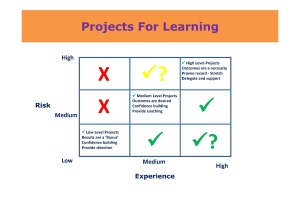Most effective people who I know use a task list to help them to stay focused throughout the day. Some randomly work their way through their list, while others start at the top and work their way down.
 A better way to manage your task list and to improve your daily effectiveness is to follow these simple steps.
A better way to manage your task list and to improve your daily effectiveness is to follow these simple steps.
1. Prepare your list
This is a classic brainstorm of all the tasks that you need to complete today. Given it is a brainstorm your list will be in a random order in terms of priority.
2. Identify your high value tasks
Rate each task in the context of value that you receive from completing the task. A ‘High’ rating means that the completed task gives you a lot of value in the context of what your role requires you to do, a ‘Medium’ rating gives you medium value and a ‘Low’ rating gives you low value.
3. Identify your hard-to-do tasks
Rate each task for how hard you find it to complete the task. A ‘High’ rating means that you find this task difficult to do (such as having that ‘important’ conversation with your colleague about her ability to meet deadlines). A ‘Medium’ rating is a task that is moderately difficult for you to do and a ‘Low’ rating is a task that you find relatively easy to do.
4. Identify how long it takes you to complete each task
Rate each task in terms of how long it will take you to complete the task. a ‘High’ rating means that the task will take you a long time to complete (you decide your time scale for yourself as it will depend on the type of work that you do), a ‘Medium’ rating means that it will take a reasonable amount of time, and a ‘Low’ rating means that you can complete the task quickly.
5. Complete your tasks in the following order
A. High Value, Hard To Do Tasks That Can Be Done Quickly (H/H/L Task Rating)
In his book Eat That Frog, Brian Tracy refers to these tasks as your frog. If you were to eat a frog at the start of each day, nothing you do for the rest of the day will be as bad as eating that frog! In this context, your High Leverage, Hard-To-Do Tasks that can be done relatively quickly are your ‘frogs’. When you do these tasks first, you clear your mind for the rest of the day. This is a terrific habit to form. When you know that at some stage during the day you are going to have to eat a frog, it clouds your mind until you do it. So you might as well get it over and done with at the start of the day! You won’t regret it!
B. High Value, Easy To Do Tasks That Can Be Done Quickly (H/L/L Task Rating)
Getting these tasks completed creates a sense of accomplishment and shortens your to-do list in the process!
C. High Value, Easy To Do Tasks That Have a Medium and/or High Time Rating
These tasks take longer for your to complete them, but they provide high value in the context of your role.
D. High Value, Hard To Do Tasks That Take a Long Time To Complete (H/H/H Task Rating)
In my world these are my proposals. Each one needs to be tailored to my clients specific needs, so they tend to take a fair amount of time to create. I require decent chunks of dedicated time to complete this task. Knowing that I have already completed other high value tasks before getting to these provides me with the clear ‘mental space‘ that I need to get on with completing this task.
E. Everything else on your list
All these tasks are the things that provide a level of value but aren’t the most important tasks that you need to get done. Sometimes you may find that these tasks can change in value if they are time related. As a deadline nears the value in completing the task may rise. If you find yourself moving these tasks across to your new task list each day (because they aren’t being completed), make sure that you continue to rate them just in case their value has changed. Another option is to set aside an hour or two every week that is dedicated to completing these tasks.
If you follow the five steps that I have outlined above you will discover that you get more high value work done than you do today. Give it a try and let me know how you go!
Gary Ryan enables talented professionals, their teams and organisations to move Beyond Being Good.



 No matter how much practice you did, if you maintained this type of self talk you will have created a self-fulfilling prophecy. Moments in to your presentation your mind will go blank. Then it will fill with the words, “See, I knew I wasn’t any good at presenting and now look at what has happened! My mind has gone blank and the senior management team now thinks that I am useless!“
No matter how much practice you did, if you maintained this type of self talk you will have created a self-fulfilling prophecy. Moments in to your presentation your mind will go blank. Then it will fill with the words, “See, I knew I wasn’t any good at presenting and now look at what has happened! My mind has gone blank and the senior management team now thinks that I am useless!“ However, self talk is not enough. It must be balanced with doing the right work and focus. The right work in this example relates to learning how to do an effective presentation and putting what you learn in to practice before you do your presentation to the senior management team. Focus refers to the skills and structure that support the action that you are taking. In this example your focus would relate to the core message that you want to convey, the key supporting arguments that you have for your message and the call to action that you want the senior management team to adopt.
However, self talk is not enough. It must be balanced with doing the right work and focus. The right work in this example relates to learning how to do an effective presentation and putting what you learn in to practice before you do your presentation to the senior management team. Focus refers to the skills and structure that support the action that you are taking. In this example your focus would relate to the core message that you want to convey, the key supporting arguments that you have for your message and the call to action that you want the senior management team to adopt.

